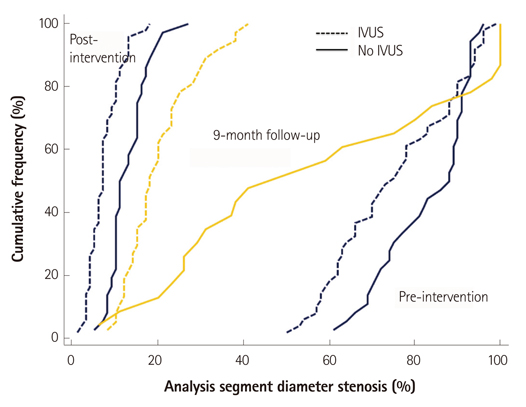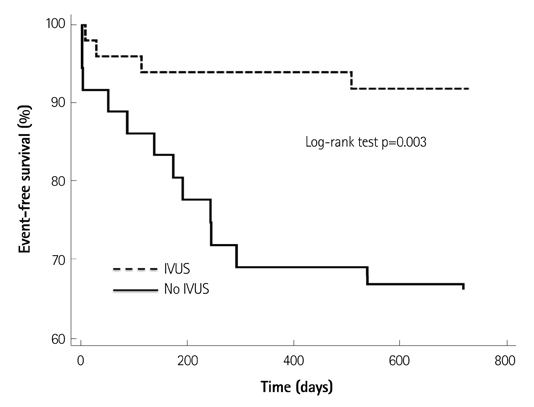Korean Circ J.
2013 Apr;43(4):231-238. 10.4070/kcj.2013.43.4.231.
Intravascular Ultrasound-Guided Percutaneous Coronary Intervention Improves the Clinical Outcome in Patients Undergoing Multiple Overlapping Drug-Eluting Stents Implantation
- Affiliations
-
- 1Division of Cardiology, Wonju College of Medicine, Yonsei University, Wonju, Korea. jyoon@yonsei.ac.kr
- KMID: 2224945
- DOI: http://doi.org/10.4070/kcj.2013.43.4.231
Abstract
- BACKGROUND AND OBJECTIVES
Stented segment length is a predictive factor for restenosis and stent thrombosis still in the drug-eluting stent (DES) era, and the benefit of routine intravascular ultrasound (IVUS) is still unclear. The aim of the present study was to investigate whether IVUS-guided percutaneous coronary intervention (PCI) improved the vascular outcomes as compared with conventional PCI in the treatment of diffuse coronary artery disease.
SUBJECTS AND METHODS
From our registry database from January 2006 to May 2009, we identified 85 consecutive patients with de novo coronary lesions treated with at least 64 mm of multiple, overlapping DES. The 2-year rate of major adverse cardiovascular events (MACE), defined as the composite of cardiovascular death, non-fatal myocardial infarction, target lesion revascularization (TLR), or stent thrombosis, was compared according to the use of IVUS.
RESULTS
The 2-year MACE rate was lower in the IVUS-guided group than that of the angiography-guided group (8% vs. 33.3%, p=0.005). The incidence of TLR was lower in patients with IVUS use than in those without IVUS use (0% vs. 27.8%, p<0.001). On Cox proportional hazard analysis, no IVUS use {hazard ratio (HR) 5.917, 95% confidence interval (CI) 1.037-33.770, p=0.045} and age (HR 1.097, 95% CI 1.006-1.138, p=0.032) were unfavorable predictors for the 2-year MACE.
CONCLUSION
The use of IVUS may improve the effectiveness and safety of multiple overlapping drug-eluting stenting for long, diffuse coronary lesions.
Keyword
MeSH Terms
Figure
Reference
-
1. Stettler C, Wandel S, Allemann S, et al. Outcomes associated with drug-eluting and bare-metal stents: a collaborative network meta-analysis. Lancet. 2007. 370:937–948.2. Hannan EL, Racz M, Holmes DR, et al. Comparison of coronary artery stenting outcomes in the eras before and after the introduction of drug-eluting stents. Circulation. 2008. 117:2071–2078.3. Aoki J, Ong AT, Rodriguez Granillo GA, et al. "Full metal jacket" (stented length > or =64 mm) using drug-eluting stents for de novo coronary artery lesions. Am Heart J. 2005. 150:994–999.4. Lee CW, Park KH, Kim YH, et al. Clinical and angiographic outcomes after placement of multiple overlapping drug-eluting stents in diffuse coronary lesions. Am J Cardiol. 2006. 98:918–922.5. Dangas GD, Claessen BE, Caixeta A, Sanidas EA, Mintz GS, Mehran R. In-stent restenosis in the drug-eluting stent era. J Am Coll Cardiol. 2010. 56:1897–1907.6. Hong SJ, Kim MH, Ahn TH, et al. Comparison of the predictors of coronary restenosis after drug-eluting stent implantation in diabetic and nondiabetic patients. Korean Circ J. 2007. 37:530–537.7. Tin-Hay EL, Poh KK, Lim YT, et al. Clinical predictors of stent thrombosis in the "real world" drug-eluting stent era. Int J Cardiol. 2010. 145:422–425.8. Brugaletta S, Costa JR Jr, Garcia-Garcia HM. Assessment of drug-eluting stents and bioresorbable stents by grayscale IVUS and IVUS-based imaging modalities. Int J Cardiovasc Imaging. 2011. 27:239–248.9. Roy P, Steinberg DH, Sushinsky SJ, et al. The potential clinical utility of intravascular ultrasound guidance in patients undergoing percutaneous coronary intervention with drug-eluting stents. Eur Heart J. 2008. 29:1851–1857.10. Claessen BE, Mehran R, Mintz GS, et al. Impact of intravascular ultrasound imaging on early and late clinical outcomes following percutaneous coronary intervention with drug-eluting stents. JACC Cardiovasc Interv. 2011. 4:974–981.11. Ahmed K, Jeong MH, Chakraborty R, et al. Role of intravascular ultrasound in patients with acute myocardial infarction undergoing percutaneous coronary intervention. Am J Cardiol. 2011. 108:8–14.12. Youn YJ, Yoon J, Lee JW, et al. Intravascular ultrasound-guided primary percutaneous coronary intervention with drug-eluting stent implantation in patients with ST-segment elevation myocardial infarction. Clin Cardiol. 2011. 34:706–713.13. Maluenda G, Lemesle G, Ben-Dor I, et al. Impact of intravascular ultrasound guidance in patients with acute myocardial infarction undergoing percutaneous coronary intervention. Catheter Cardiovasc Interv. 2010. 75:86–92.14. Cannon CP, Battler A, Brindis RG, et al. American College of Cardiology key data elements and definitions for measuring the clinical management and outcomes of patients with acute coronary syndromes. A report of the American College of Cardiology Task Force on Clinical Data Standards (Acute Coronary Syndromes Writing Committee). J Am Coll Cardiol. 2001. 38:2114–2130.15. Kappetein AP, Head SJ, Généreux P, et al. Updated standardized end-point definitions for transcatheter aortic valve implantation: the Valve Academic Research Consortium-2 consensus document. J Am Coll Cardiol. 2012. 60:1438–1454.16. Task Force on Myocardial Revascularization of the European Society of Cardiology (ESC) and the European Association for Cardio-Thoracic Surgery (EACTS). European Association for Percutaneous Cardiovascular Interventions (EAPCI). Winjs W, et al. Guidelines on myocardial revascularization. Eur Heart J. 2010. 31:2501–2555.17. Levine GN, Bates ER, Blankenship JC, et al. 2011 ACCF/AHA/SCAI Guideline for Percutaneous Coronary Intervention: a report of the American College of Cardiology Foundation/American Heart Association Task Force on Practice Guidelines and the Society for Cardiovascular Angiography and Interventions. Circulation. 2011. 124:e574–e651.18. Hur SH, Kang SJ, Kim YH, et al. Impact of intravascular ultrasound-guided percutaneous coronary intervention on long-term clinical outcomes in a real world population. Catheter Cardiovasc Interv. 2011. [Epub ahead of print].19. Park SJ, Kim YH, Park DW, et al. Impact of intravascular ultrasound guidance on long-term mortality in stenting for unprotected left main coronary artery stenosis. Circ Cardiovasc Interv. 2009. 2:167–177.20. Kim SH, Kim YH, Kang SJ, et al. Long-term outcomes of intravascular ultrasound-guided stenting in coronary bifurcation lesions. Am J Cardiol. 2010. 106:612–618.21. Kim JS, Hong MK, Ko YG, et al. Impact of intravascular ultrasound guidance on long-term clinical outcomes in patients treated with drug-eluting stent for bifurcation lesions: data from a Korean multicenter bifurcation registry. Am Heart J. 2011. 161:180–187.22. Hong MK, Mintz GS, Lee CW, et al. Intravascular ultrasound predictors of angiographic restenosis after sirolimus-eluting stent implantation. Eur Heart J. 2006. 27:1305–1310.23. Okabe T, Mintz GS, Buch AN, et al. Intravascular ultrasound parameters associated with stent thrombosis after drug-eluting stent deployment. Am J Cardiol. 2007. 100:615–620.24. Cook S, Ladich E, Nakazawa G, et al. Correlation of intravascular ultrasound findings with histopathological analysis of thrombus aspirates in patients with very late drug-eluting stent thrombosis. Circulation. 2009. 120:391–399.
- Full Text Links
- Actions
-
Cited
- CITED
-
- Close
- Share
- Similar articles
-
- Is There a Benefit of Drug-Eluting Stents Rather than Bare Metal Stents in Large Coronary Artery Lesions?
- Percutaneous Treatment of an Injured Coronary Stent Using the Looping Wire Technique
- Systemic drug therapy and restenosis after drug-eluting stent implantation
- Drug eluting Stent and Percutaneous Coronary Intervention
- Intravascular Ultrasound-Guided Percutaneous Coronary Intervention with Drug-eluting Stent for Unprotected Left Main Disease via Left Snuffbox Approach



